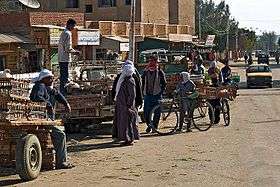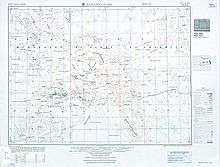Bahariya Oasis
El-Wahat el-Bahariya or el-Bahariya (Arabic: الواحات البحرية al-Wāḥāt al-Baḥrīya, "the Northern Oases"; Coptic: ϯⲟⲩⲁϩ `ⲙⲡⲉⲙϫⲉ Diwah Ēmbemdje, "Oasis of Bemdje", Old Coptic: ⲧⲁⲥⲧ(ⲥ), from Egyptian ḏsḏs[1]) is a depression and oasis in the Western Desert of Egypt. It is approximately 370 km away from Cairo. The roughly oval valley extends from northeast to southwest, has a length of 94 km, a maximum width of 42 km and covers an area of about 2000 km².
Bahariya Oasis الواحات البحرية ϯⲟⲩⲁϩ `ⲙⲡⲉⲙϫⲉ | |
|---|---|
     Clockwise from top: A workday, Desert Safari Home Hotel, Desert Oasis Gallery, Oasis Palms, El Beshmo Lodge | |
 Bahariya Oasis Location in Egypt | |
| Coordinates: 28°21′5.36″N 28°51′44.6″E | |
| Country | |
| Governorate | Giza Governorate |
| Time zone | UTC+2 (EST) |
The valley is surrounded by mountains and has numerous springs. Located in Giza Governorate, the main economic sectors are agriculture, iron ore mining, and tourism. The main agricultural products are guavas, mangos, dates, and olives.
Settlement
Bahariya consists of many villages, of which El Bawiti is the largest and the administrative center. Qasr is el-Bawiti's neighboring/twin village. To the east, about ten kilometers away are the villages of Mandishah and el-Zabu. A smaller village called el-'Aguz lies between El Bawiti and Mandishah. Harrah, the eastern most village, is a few kilometers east of Mandishah and el-Zabu. El Hayz, also called El-Hayez, is the southern most village, but it may not always be considered as part of Bahariya because it is so far from the rest of the villages, about fifty kilometers south of El Bawiti. There is an oasis at El-Hayez[2] where mummies have been found on which genetic studies have been conducted.[3]
People and culture
The people of the oasis, or the Waḥātī people (meaning "of the oasis" in Arabic), are the descendants of the ancient people who inhabited the oasis, Bedouin tribes from Libya and the north coast, and other people from the Nile Valley who came to settle in the oasis.
The majority of Waḥātī people in Bahariya are Muslims. There are some mosques in Bahariya. The nature of social settings in the oasis is highly influenced by Islam.
Also, traditional music is very important to the Waḥātī people. Flutes, drums, and the simsimeyya (a harp-like instrument) are played at social gatherings, particularly at weddings. Traditional songs sung in rural style are passed down from generation to generation, and new songs are invented as well. Music from Cairo, the greater Middle East, and other parts of the world are now easily accessible to the people of the oasis.
Names
In Ancient Egypt the depression was known under two names. The form Djesdjes is first mentioned on a scarab dating back to the Middle Kingdom. In the New Kingdom, however, this name is rarely found, but does appear for example in the Temple of Luxor or in the account of King Kamose, who occupied the oasis during the war against the Hyksos. From the 25th Dynasty it was almost the only name used. The other name Wḥ3.t mḥty.t ("the Northern Oasis") was almost exclusively used in the New Kingdom, it appears for instance on the local grave of Amenhotep, and is found again in the list of oasis in the Temple at Edfu.
From 45 CE the depression is known in Latin as Oasis parva (Small Oasis). The Greek historian Strabo (63 BCE – 23 CE) calls it the ‘Second Oasis’; the historian Olympiodorus of Thebes (5th century CE: Byzantine Era) calls it ‘the Third Oasis. In Coptic times it was known as the Oasis of Bemdje (the ancient Oxyrhynchos, nowadays known as al-Bahnasa) and in Islamic times it was called the Oasis of Bahnasa.
The modern name is الواحات البحرية, al-Wāḥāt al-Baḥriyya meaning "the Northern Oasis”. The southern part of the depression around El Heiz apparently never had a separate name.
Agriculture
Agriculture is still an important source of income, though now the iron ore industry close to Bahariya provides jobs for many Wahati people. Recently there has also been an increase in tourism to the oasis because of antiquities (tombs, mummies and other artifacts have been discovered there), and because of the beautiful surrounding deserts. Wahati and foreign guides lead adventure desert tours based out of Bahariya to the surrounding White and Black deserts, and sometimes to Siwa or the southern oases. Tourism is a new and important source of income for locals, and it has brought an international presence to the oasis.[4]
History

The depression was populated since the neolithic, even if there is no archaeological evidence to all times. In el-Haiz, a prehistoric settlement site of hunter-gatherers was found with remains of grindstones, arrowheads, scrapers, chisels, and ostrich eggshells. In Qārat el-Abyaḍ, a Czech team led by Miroslav Bárta discovered a settlement of the Old Kingdom.[5] Rock inscriptions in el-Harrah and other records date to the Middle Kingdom and upwards.[6][7] The tomb of Amenhotep called Huy was erected in Qarat Hilwah at the end of the 18th dynasty.[8] In the 26th dynasty, the depression was culturally and economically flourishing. This can be learned from the chapels in 'Ain el-Muftilla, the tombs in Qārat Qasr Salim and Qarat esh-Sheikh Subi,[9] and the site of Qasr 'Allam.[10]
A newly flourishing time occurs at the Greek-Roman time. There is the ruin of a temple to Alexander the Great located in Qasr el-Miqisba ('Ain et-Tibniya).[11] It is believed by some Egyptologists that the Greek conqueror passed through Bahariya while returning from the oracle of Ammon at Siwa Oasis. Excavations of the Greco-Roman necropolis found in 1995[12] and known as the Valley of the Golden Mummies began in 1999. Approximately thirty-four tombs have been excavated from this area.[13] In Roman times, a big military fort was erected at Qarat el-Toub.[14]
In the spring of 2010, a Roman-era mummy was unearthed in a Bahariya Oasis cemetery in el-Harrah. The 3-foot-tall female mummy was found covered with plaster decorated to resemble Roman dress and jewelry. In addition to the female mummy, archaeologists found clay and glass vessels, coins, anthropoid masks and 14 Greco-Roman tombs. Director of Cairo and Giza Antiquities Mahmoud Affifi, the archaeologist who led the dig, said the tomb has a unique design with stairways and corridors, and could date to 300 BC. This find came as a result of excavation work for the construction of a youth center.[15]
Carcharodontosaurus and Bahariasaurus (meaning "Bahariya lizard") dinosaurs have been found in the Bahariya Formation, which date to about 95 million years ago. It was a huge theropod, it was described by Ernst Stromer in 1934,[16] though the type specimen was destroyed during World War II in 1944. In 2000, an American scientific team conducted by Joshua Smith found the remains of this type of dinosaur, the Paralititan stromeri.[17]
However, the region between the Bahariya and Farafra depressions used to have volcanic activity during the Jurassic Period. In addition, the landscape contains some hills made of barite or calcite crystals, and also golden limestone boulders which became a sanctuary for species, such as white foxes, gazelles and rams.[18]
Modernity
During the World War I the Baharia Military Railway was built to provide access to the oasis. The oasis has changed drastically in the past 30 years after an asphalt road connecting Bahariya to Cairo was finished in the early 70s. With the new road came electricity, cars, television, phone lines, a more accessible route to Cairo, and, latterly, Internet. The spread of people and ideas between Bahariya and Cairo has increased dramatically since the road was constructed. Also, the language of the Waḥātī people has been changed and influenced in new ways as the Cairene dialect is heard on television and in music.[4]
Notes
- Osing, Jürgen (1998). Hieratische Papyri aus Tebtunis I. Copenhagen. p. 55.
- "El-Hayz". Egyptian Monuments. 14 March 2009. Retrieved 6 June 2017.
- Kujanová, M; Pereira, L; Fernandes, V; Pereira, JB; Cerný, V (October 2009). "Near eastern neolithic genetic input in a small oasis of the Egyptian Western Desert". American Journal of Physical Anthropology. 140 (2): 336–46. doi:10.1002/ajpa.21078. PMID 19425100.
- Bliss, Frank: Oasenleben : die ägyptischen Oasen Bahriya und Farafra in Vergangenheit und Gegenwart, Bonn: Politischer Arbeitskreis Schulen (PAS), 2006, (Beiträge zur Kulturkunde; 23), ISBN 978-3-921876-27-5.
- Nevine El-Aref: The tale of a city, report of the Al-Ahram Weekly of August 9, 2007.
- Giddy, Lisa L.: Egyptian Oases : Bahariya, Dakhla, Farafra and Kharga During Pharaonic Times, Warminster: Aris & Phillips Ltd., 1987, pp. 15 sq., 40–44, 62–64, 66, 95, 146–149, 161–163.
- Castel, Georges ; Tallet, Pierre: Les inscriptions d’El-Harra, oasis de Bahareya, in: Bulletin de l’Institut français d’archéologie orientale (BIFAO), vol. 101 (2001), pp. 99–136, 612 sq.
- Siclen III, Charles Cornell van: Wall scenes from the tomb of Amenhotep (Huy) governor of Bahria Oasis, San Antonio, Texas: VanSiclen, 1981.
- Fakhry, op. cit.
- Colin, Frédéric: Qasr Allam : a Twenty-Sixth Dynasty settlement, in: Egyptian archaeology : the bulletin of the Egypt Exploration Society, ISSN 0962-2837, vol. 24 (2004), pp. 30–33.
- Fakhry, Ahmed: Baḥria Oasis, vol. II. Cairo: Government Press, 1950, pp. 41–47, 85, figs. 29 [map], 30, 71, plates XXIV–XXXV, XLIV.B.
- Associated Press: Zweitausend Jahre alte Mumien in ägyptischer Oase entdeckt, in: Frankfurter Allgemeine Zeitung, Nr. 132, 1995, Friday, 09.06.1995, p. 11.
- Zahi Hawass, The Valley of the Golden Mummies, New York 2000.
- Colin, Frédéric; Laisney, Damien; Marchand, Sylvie: Qaret el-Toub : un fort romain et une nécropole pharaonique. Prospection archéologique dans l’oasis de Baḥariya 1999, in: Bulletin de l’Institut français d’archéologie orientale (BIFAO), vol. 100 (2000), pp. 145–192.
- Nevine El-Aref: In the sands of time, report of Al-Ahram Weekly of April 29, 2010.
- Stromer, E.: Ergebnisse der Forschungsreisen Prof. E. Stromers in den Wüsten Ägyptens : II. Wirbeltierreste der Baharîje-Stufe (unterstes Cenoman). 13. Dinosauria, in: Abhandlungen der Bayerischen Akademie der Wissenschaften, Mathematisch-Naturwissenschaftliche Abteilung, Neue Folge, vol. 22 (1934), pp. 1–79.
- Smith, Joshua et al.: A Giant sauropod dinosaur from an Upper Cretaceous mangrove deposit in Egypt, in: Science, vol. 292,5522 (2001), pp. 1704–1706.
- "Bahariya and Farafra: Egypt's bizarre, desert landscape". BBC. 29 March 2020.
See also
- Bahariasaurus (meaning "Bahariya lizard")
- Bahariya Formation (fossil bearing geologic formation)
- Ernst Stromer
References
- Fakhry, Ahmed. Bahria Oasis, Cairo: Government Press, 1942–1950 (2 volumes).
- Fakhry, Ahmed. The oases of Egypt. Vol. II: Bahrīyah and Farafra Oases, Cairo: The American Univ. in Cairo Pr., 1974, reprinted 2003.
- Hawass, Zahi A. Valley of the golden mummies : the greatest Egyptian discovery since Tutankhamen, London: Virgin, 2000.
External links
| Wikimedia Commons has media related to Bahariya Oasis. |
| Wikivoyage has a travel guide for Bahariyya. |
- (in German) Baḥrīya on Wikivoyage
